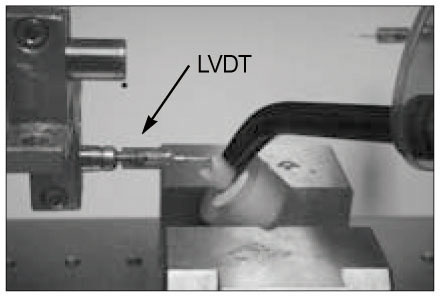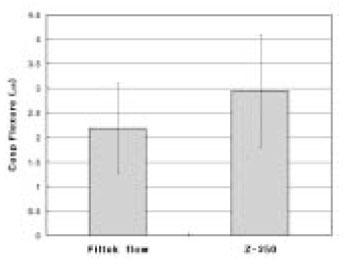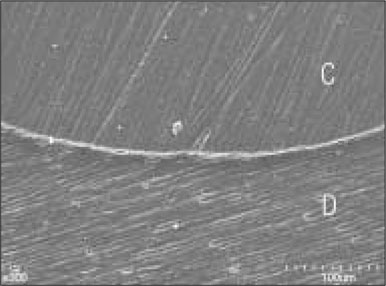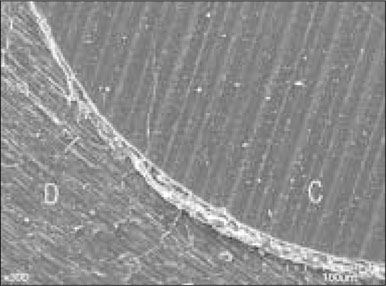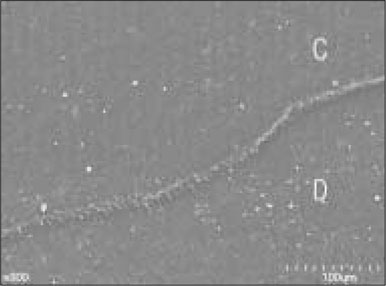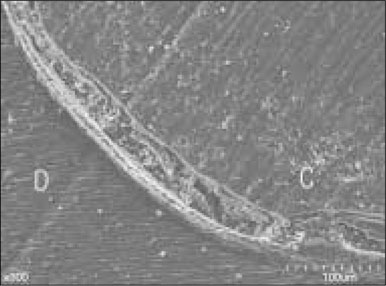Cuspal deflection in class V cavities restored with composite resins
- Affiliations
-
- 1Department of Conservative Dentistry, School of Dentistry, Seoul National University, Korea. inboglee@snu.ac.kr
- 2Department of Dental Biomaterials Science, School of Dentistry, Seoul National University, Korea.
- KMID: 1986752
- DOI: http://doi.org/10.5395/JKACD.2008.33.2.083
Abstract
- The purpose of this study was to evaluate the effect of the polymerization shrinkage and modulus of elasticity of composites on the cusp deflection of class V restoration in premolars. The sixteen extracted upper premolars were divided into 2 groups with similar size. The amounts of cuspal deflection were measured in Class V cavities restored with a flowable composite (Filtek flow) or a universal hybrid composite (Z-250). The bonded interfaces of the sectioned specimens were observed using a scanning electron microscopy (SEM). The polymerization shrinkage and modulus of elasticity of the composites were measured to find out the effect of physical properties of composite resins on the cuspal deflection. The results were as follows. 1. The amounts of cuspal deflection restored with Filtek flow or Z-250 were 2.18 +/- 0.92 microm and 2.95 +/- 1.13 microm, respectively. Filtek flow showed less cuspal deflection but there was no statistically significant difference (p > 0.05). 2. The two specimens in each group showed gap at the inner portion of the cavity. 3. The polymerization shrinkages of Filtek flow and Z-250 were 4.41% and 2.23% respectively, and the flexural modulus of elasticity of cured Filtek flow (7.77 GPa) was much lower than that of Z-250 (17.43 GPa). 4. The cuspal deflection depends not only on the polymerization shrinkage but also on the modulus of elasticity of composites.
Keyword
MeSH Terms
Figure
Cited by 4 articles
-
Effect of instrument compliance on the polymerization shrinkage stress measurements of dental resin composites
Deog-Gyu Seo, Sun-Hong Min, In-Bog Lee
J Korean Acad Conserv Dent. 2009;34(2):145-153. doi: 10.5395/JKACD.2009.34.2.145.Comparison of marginal microleakage between low and high flowable resins in class V cavity
Sang-Bae Bae, Young-Gon Cho, Myeong-Seon Lee
J Korean Acad Conserv Dent. 2009;34(6):477-483. doi: 10.5395/JKACD.2009.34.6.477.The change of the initial dynamic visco-elastic modulus of composite resins during light polymerization
Min-Ho Kim, In-Bog Lee
J Korean Acad Conserv Dent. 2009;34(5):450-459. doi: 10.5395/JKACD.2009.34.5.450.A survey on the use of composite resin in Class II restoration in Korea
Dong-Ho Shin, Se-Eun Park, In-Seok Yang, Juhea Chang, In-Bog Lee, Byeong-Hoon Cho, Ho-Hyun Son
J Korean Acad Conserv Dent. 2009;34(2):87-94. doi: 10.5395/JKACD.2009.34.2.087.
Reference
-
1. Watts DC, Cash AJ. Determination of polymerization shrinkage kinetics in visible-light-cured materials: methods development. Dent Mater. 1991. 7(4):281–287.
Article2. Lee IB, Cho BH, Son HH, Um CM. A new method to measure the polymerization shrinkage kinetics of light cured composites. J Oral Rehabil. 2005. 32(4):304–314.
Article3. Lee IB, Cho BH, Son HH, Um CM, Lim BS. The effect of consistency, specimen geometry and adhesion on the axial polymerization shrinkage measurement of light cured composites. Dent Mater. 2006. 22(11):1071–1079.
Article4. Davidson CL, de Gee AJ, Feilzer AJ. The competition between the composite-dentin bond strength and the polymerization contraction stress. J Dent Res. 1984. 63(12):1396–1399.
Article5. Neiva IF, de Andrada MA, Baratieri LN, Monteiro S, Ritter AV Jr. An in vitro study of the effect of restorative technique on marginal leakage in posterior composites. Oper Dent. 1998. 23(6):282–289.6. Holan G, Levin M, Bimstein E, Grajower R, Eidelman E. Clinical, radiographic, SEM evaluation and assessment of microleakage of class II composite restorations. Am J Dent. 1989. 2(5):274–278.7. Eick JD, Welch FH. Polymerization shrinkage of posterior composite resins and its possible influence on postoperative sensitivity. Quintessence Int. 1986. 17(2):103–111.8. Opdam NJ, Roeters FJ, Feilzer AJ, Verdonschot EH. Marginal integrity and postoperative sensitivity in Class 2 resin composite restorations in vivo. J Dent. 1998. 26(7):555–562.
Article9. Pearson GJ, Hegarty SM. Cusp movement of molar teeth with composite filling materials in conventional and modified MOD cavities. Br Dent J. 1989. 166(5):162–165.
Article10. Meredith N, Setchell DJ. In vitro measurement of cuspal strain and displacement in composite restored teeth. J Dent. 1997. 25(3-4):331–337.
Article11. Segura A, Donly KJ. In vitro posterior composite polymerization recovery following hygroscopic expansion. J Oral Rehabil. 1993. 20(5):495–499.
Article12. Rees JS, Jagger DC, Williams DR, Brown G, Duguid W. A reappraisal of the incremental packing technique for light cured composite resins. J Oral Rehabil. 2004. 31(1):81–84.
Article13. Abbas G, Fleming GJ, Harrington E, Shortall AC, Burke FJ. Cuspal movement and microleakage in premolar teeth restored with a packable composite cured in bulk or in increments. J Dent. 2003. 31(6):437–444.
Article14. Fleming GJ, Hall DP, Shortall AC, Burke FJ. Cuspal movement and microleakage in premolar teeth restored with posterior filling materials of varying reported volumetric shrinkage values. J Dent. 2005. 33(2):139–146.
Article15. Lee MR, Cho BH, Son HH, Um CM, Lee IB. Influence of cavity dimension and restoration methods on the cusp deflection of premolars in composite restoration. Dent Mater. 2007. 23(3):288–295.
Article16. McCullock AJ, Smith BG. In vitro studies of cuspal movement produced by adhesive restorative materials. Br Dent J. 1986. 161(11):405–409.
Article17. Versluis A, Douglas WH, Cross M, Sakaguchi RL. Does an incremental filling technique reduce polymerization shrinkage stresses? J Dent Res. 1996. 75(3):871–878.
Article18. Feilzer AJ, Dooren LH, de Gee AJ, Davidson CL. Influence of light intensity on polymerization shrinkage and integrity of restoration-cavity interface. Eur J Oral Sci. 1995. 103(5):322–326.
Article19. Uno S, Asmussen E. Marginal adaptation of a restorative resin polymerized at reduced rate. Scand J Dent Res. 1991. 99(5):440–444.
Article20. Alomari QD, Reinhardt JW, Boyer DB. Effect of liners on cusp deflection and gap formation in composite restorations. Oper Dent. 2001. 26(4):406–411.21. Davidson CL, deGee AJ. Relaxation of polymerization contraction stresses by flow in dental composites. J Dent Res. 1984. 63(2):146–148.
Article22. Brännström M. Communication between the oral cavity and the dental pulp associated with restorative treatment. Oper Dent. 1984. 9(2):57–68.23. Brännström M, Johnson G, Linden LA. Fluid flow and pain response in the dentin produced by hydrostatic pressure. Odontol Revy. 1969. 20(1):15–30.
- Full Text Links
- Actions
-
Cited
- CITED
-
- Close
- Share
- Similar articles
-
- Effect of intermittent polymerization on the rate of polymerization shrinkage and cuspal deflection in composite resin
- Correlation between Linear polymerization shrinkage & tooth cuspal deflection
- Measurements of shrinkage stress and reduction of inter-cuspal distance in maxillary premolars resulting from polymerization of composites and compomers
- Influence of cavity size and restoration methods on the cusp deflection in composite restoration
- Comparison of marginal microleakage between low and high flowable resins in class V cavity

